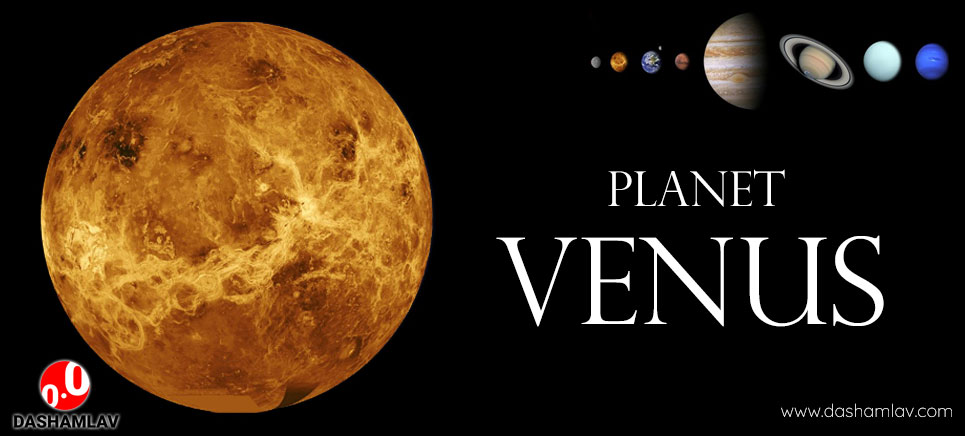Venus is second closest planet from the Sun. It is named after Venus — the Roman goddess of love and beauty — probably because of its bright shiny appearance in the sky. Venus is also known as the morning star and evening star. Venus is often refer to as the sister planet or twin planet of Earth.
Facts about Venus
- Venus is very bright
Planet Venus is the second brightest object in our skies — after the Moon. If sky is perfectly clear, Venus can be seen even during the day. Atmosphere of Venus has plenty of sulfuric acid clouds. These clouds make it reflective and thus shiny bright. But at the same time, this brightness hides Venus’ surface from us. - Venus spins clockwise
Unlike other planets, Venus spins on its axis in clockwise fashion. It is believed that long time ago a massive celestial body collided with Venus so hard that the collision made the planet upside down. This is the reason why Venus spins in the opposite direction. - A day on Venus is longer than the year
Venus spins very slowly on its axis. In fact Venus is slowest in spinning among its solar system companions. It takes 243 Earth days for Venus to complete one rotation on its axis. In contrast, it completes one revolution around the Sun in just 225 Earth days! - Venus was first planet whose motion through the sky was fully plotted
As early as second millennium BC, humans had completely plotted Venus’ movement in the sky. The planet is easy to spot due to its brightness and this is why its movement was easier to record.

- Venus is the hottest planet
Although Mercury is closest to the Sun, Venus is hotter than even Mercury. Surface temperature on Venus can be as high as 462 °C (864 °F) due to greenhouse effect in its atmosphere. - You will buckle under Venusian atmosphere
The mass of Venus’ atmosphere is 93 times that of Earth’s. Such a dense atmosphere exerts the pressure at Venus’ surface which is 92 times that at Earth’s atmosphere. This atmospheric pressure is equivalent to that at a depth of nearly 1 km under Earth’s oceans. - Venus is called Earth’s sister planet
Both Venus and Earth are of almost the same size. There is a difference of only 638 km in the diameters of Earth and Venus. Also, both have comparable mass — Venus has 81% mass of Earth. Both planets have a central core, a molten mantle and a crust. - Venus has phases like the Moon
In 1610 Galileo Galilei, discovered that Venus demonstrates phases like moon. This proved two things. One that Venus revolves around the Sun and not the Earth. Second, Venus orbits around the Sun inside the Earth’s orbit. When Venus is on the opposite side of the Sun, it appears to us as full. But when it comes between Earth and the Sun, it shows phases like the Moon. - Venus is the first planet where a man-made spacecraft soft-landed
The Soviet spacecraft Venera 7 landed on Venus’ surface on 15 December 1970. Venera 7 transmitted information from Venus’ surface for 23 minutes. The spacecraft definitively confirmed that humans cannot survive on the surface of Venus, and excluded the possibility that there is any liquid water on Venus. - Venus transit is rare but it happens
Only Mercury and Venus are planets that come between Earth and the Sun — therefore they appear against the surface of the Sun. The orbit of Venus is slightly inclined with respect to Earth’s. As a result, when Venus comes between Earth and Sun, it does not always appear on the face of the Sun. But sometime it does! The last time, Venus transit happened on 05 June 2012.
Statistics about Planet Venus
| Property | Value |
|---|---|
| Venus’ radius | 6,051.8 km (0.9499 Earths) |
| Venus’ surface area | 4.6023×108 km2 (0.902 Earths) |
| Venus’ volume | 9.2843×1011 km3 (0.866 Earths) |
| Venus’ mass | 4.8675×1024 kg (0.815 Earths) |
| Mean density | 5.243 g/cm3 |
| Venus’ average distance from Sun | 108.94 million km |
| Perihelion (closest approach to the Sun) | 107,477,000 km |
| Aphelion (farthest distance from the Sun) | 108,939,000 km |
| Length of solar day (single rotation on its axis) | 243 Earth days |
| Length of year (single revolution around the Sun) | 224.7 Earth days |
| Equatorial inclination to orbit (axial tilt) | 2.64 degrees |
| Rotation speed at Equator | 6.52 km/h (1.81 m/s) |
| Surface gravity | 8.87 m/s2 (0.904 g) |
| Escape velocity | 10.36 km/s (6.44 mi/s) |
| Natural satellite | Doesn’t have any natural satellite. |
| Venus’ composition | 96.5% carbon dioxide 3.5% nitrogen 0.015% sulfur dioxide 0.0070% argon 0.0020% water vapour 0.0017% carbon monoxide 0.0012% helium 0.0007% neon Trace carbonyl sulfide Trace hydrogen chloride Trace hydrogen fluoride |
Citation
Use the citation below to add this article to your bibliography
Use the citation below to add this article to your bibliography
Styles:
"Planet Venus: Interesting Facts about Twin Sister of Earth." Dashamlav.com. Web. 30 April 2025. <https://dashamlav.com/planet-venus-facts/>
Dashamlav.com, "Planet Venus: Interesting Facts about Twin Sister of Earth." Accessed 30 April 2025. https://dashamlav.com/planet-venus-facts/
"Planet Venus: Interesting Facts about Twin Sister of Earth." (n.d.). Dashamlav.com. Retrieved 30 April 2025 from https://dashamlav.com/planet-venus-facts/
